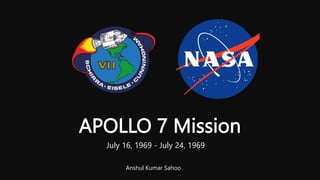
Apollo 7 Mission
- 1. APOLLO 7 Mission July 16, 1969 - July 24, 1969 Anshul Kumar Sahoo
- 2. CONTENT 1. Mission Objective 2. Apollo 7 Crew 3. Mission Background 4. Return to Earth 5. Gallery 6. Reference
- 3. MISSION OBJECTIVE The primary objectives of Apollo 7 were: • To test the Apollo Command and Service Module (CSM) in Earth orbit. • To demonstrate crew, launch vehicle, and mission support facilities performance during a crewed CSM mission. • To demonstrate the CSM rendezvous capability.
- 4. APOLLO 12 CREW Portrait of the prime crew of the Apollo 7 Mission Left to right: Eisele, Schirra, Cunningham
- 5. APOLLO 11 CREW Walter M. Schirra Commander Mission Insignia
- 6. APOLLO 11 CREW Donn F. Eisele Command Module Pilot Mission Insignia
- 7. APOLLO 11 CREW R. Walter Cunningham Lunar Module Pilot Mission Insignia
- 8. Apollo 7 lifts off from Cape Kennedy Launch Complex 34 at 11:03 A.M., EDT. MISSION BACKGROUND
- 9. MISSION BACKGROUND • After the Apollo 1 accident, NASA initiated significant modifications to the Apollo CM. Flammable materials were replaced, the pure oxygen atmosphere during ground operations was reassessed, and the hatch design was revised to allow for rapid egress in emergencies. • The work that went into these changes was extensive and reflected in the Apollo 7 mission, where the redesigned Command and Service Modules (CSM) would be tested in space for the first time. • The Apollo 7 mission was designed to pave the way for the ambitious flights that would follow. NASA's plan for achieving a Moon landing involved several preparatory steps, and a successful Apollo 7 mission was essential to validate the spacecraft's design, systems, and operational procedures before proceeding to more complex missions like the lunar orbit of Apollo 8.
- 10. MISSION BACKGROUND Apollo 7 was notable for carrying the first live television broadcasts from an American spacecraft. The crew broadcast multiple times, giving viewers on Earth a unique glimpse into life in space. These broadcasts were an early example of the merging of space exploration with the global media, paving the way for iconic broadcasts in subsequent Apollo missions.
- 11. Apollo 7 S-IVB stage in Earth orbit MISSION BACKGROUND
- 12. RETURN TO EARTH Apollo 7 splashed down in the Atlantic Ocean, south of Bermuda, on October 22, 1968. The splashdown was relatively close to the targeted location, demonstrating the accuracy of the reentry process.
- 13. RETURN TO EARTH
- 14. GALLERY Technicians assist the crew of Apollo 7 during spacecraft egress training at the Kennedy Space Center. July 4, 1968. Scan by Ed Hengeveld. The Apollo 7 crew poses for a photo. August, 1968. Scan by Ed Hengeveld.
- 15. GALLERY Apollo 7 at Complex 34 during countdown demonstration test. September 16, 1968. Scan by J.L. Pickering Buzz Aldrin moves toward a position to deploy two components of the Early Apollo Scientific Experiments Package (EASEP) on the surface of the moon during the Apollo 11 mission.
- 16. GALLERY Apollo 7 crew goes through suiting up operations in the Manned Spacecraft Operations Building at KSC during prelaunch countdown. Front to rear are Schirra, Eisele and Cunningham Schirra leads crew at base of Pad 34 on launch day
- 17. GALLERY liftoff of Apollo 7 from Cape Kennedy Launch Complex 34 Apollo 7 lifts off from Cape Kennedy Launch Complex 34 at 11:03 A.M., EDT. liftoff of Apollo 7
- 18. GALLERY Apollo 7 S-IVB stage in Earth orbit Apollo 7 S-IVB stage and docking practice target
- 19. GALLERY Apollo 7 S-IVB stage in Earth orbit view of CM window
- 20. GALLERY
- 21. GALLERY Apollo 7 astronaut Donn F. Eisele during mission crewmember photographed during Apollo 7 mission
- 22. GALLERY Wally Schirra during Apollo 7 mission Apollo 7 astronaut Donn F. Eisele during mission
- 23. GALLERY Sinai Peninsula viewed from Apollo 7 The Florida Peninsula viewed from Apollo 7
- 24. GALLERY
- 25. GALLERY
- 26. GALLERY
- 27. GALLERY
- 28. GALLERY
- 29. GALLERY
- 30. GALLERY
- 31. GALLERY
- 32. GALLERY
- 33. GALLERY underside of Apollo 7 Command Module during recovery Apollo 7 crew arrives aboard recovery ship U.S.S. Essex
- 34. GALLERY The Apollo 7 Command Module bobs in the Atlantic as a Sea King helicopter recovers its three-man crew. The three spheres atop the conical CM capsule are flotation devices designed to right it in the event it tipped and floated in the ocean nose down. Image credit: NASA